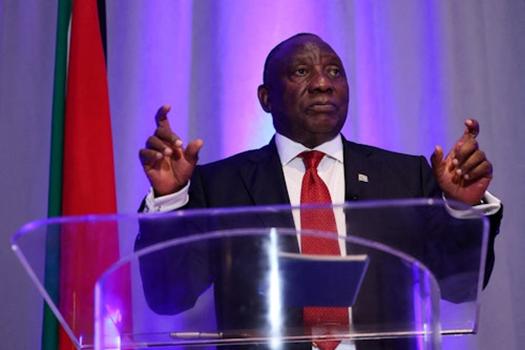
On July 7, 2025, U.S. President Trump announced on social media that a 30% tariff would be imposed on South African products exported to the United States, along with a threat to levy even higher tariffs on goods circumventing duties through third-country transshipment. This unilateral move not only triggered a strong backlash from the South African government but also brought to the forefront profound issues such as the restructuring of the global industrial chain, the reshaping of trade rules, and the rise of "Global South" countries. As the U.S. brandishes the tariff stick, it reveals a fierce clash between unilateral hegemony and the trend of multipolarity, with "Global South" countries seizing this opportunity to accelerate their quest for breakthroughs.
I. Tariff Bullying: The "U.S. Algorithm" Shrouded in Data Fog and the Tearing of the Global Industrial Chain
The Trump administration claimed that the 30% tariff was formulated based on the principle of "reciprocity," aiming to eliminate the "unfair barriers" faced by U.S. goods in the South African market. However, South Africa's official trade data tore off the veil of this pretext: South Africa imposes an average tariff of 7.6% on imported goods, with 56% of them entering at Most-Favored-Nation (MFN) duty-free status and 77% of U.S. goods directly enjoying zero-tariff treatment. Even more ironically, the "trade deficit algorithm" relied upon by the U.S. is highly controversial—it derived the 30% average tariff rate by dividing the 2024 trade deficit of $8.8 billion with South Africa by the import volume and then halving it, a formula even U.S. allies have questioned for its rationality.
This "double standard" is particularly evident among African countries. For instance, Lesotho, a small landlocked country in Africa, faces a 50% tariff hike on its denim exports to the U.S., despite its total foreign trade accounting for only 0.01% of U.S. imports. The U.S. tariff policy toward African countries essentially weaponizes the African Growth and Opportunity Act (AGOA), a tool originally intended to promote African development, by threatening reviews or revocations of eligibility to exert pressure, exposing its true face of "trade bullying."
From the perspective of the global industrial chain, the U.S. tariff policy is like a stone thrown into a calm lake, with ripples rapidly spreading to every corner. The South African stock market plummeted by 4.5% in a single day after the tariff announcement, with a market value evaporation of nearly 1 trillion rand, marking the largest drop since 2020. The automotive industry, agriculture, mining, and other pillar sectors bore the brunt: citrus farms faced the risk of losing 35,000 jobs, while exports of strategic resources such as iron ore and diamonds were obstructed. More profoundly, global supply chain demand for South African minerals may shrink significantly, thereby hindering global economic growth.
II. The Breakthrough of the "Global South": From Passive Response to Proactive Layout
Faced with U.S. tariff pressure, "Global South" countries have not remained idle. Instead, they have taken regional integration and trade diversification as breakthrough points to accelerate the construction of autonomous and controllable industrial chains. The South African government swiftly rolled out response strategies: on the one hand, it pushed for the establishment of balanced and mutually beneficial trade relations with the U.S. through diplomatic channels; on the other hand, it made export destination diversification a core strategy, focusing on expanding markets in Africa, Asia, Europe, the Middle East, and the Americas, while leveraging the African Continental Free Trade Area (AfCFTA) to promote intraregional trade. For example, the South African Minerals Council is promoting the transformation of raw materials into high-value finished products to reduce tariff risks, while the automotive industry is enhancing local production capacity through strategic investments to reduce reliance on the U.S. market.
The breakthrough efforts of African countries serve as a model. Kenya, Ethiopia, and other nations have strengthened economic and trade cooperation with East Asian and Middle Eastern countries, expanding market access through mechanisms such as the Belt and Road Initiative and the Forum on China-Africa Cooperation. Data shows that by 2025, the proportion of intraregional trade in Africa has risen from 10% in 2010 to 18%, signaling a significant acceleration in regional economic integration. This "huddling for warmth" strategy not only enhances the risk resilience of African countries but also provides new options for the restructuring of the global industrial chain.
III. A New Multipolar Landscape: Trade Rule Restructuring and Global Governance Transformation
The U.S. tariff policy is essentially a countercurrent against the trend of multipolarity. While "Global South" countries are elevating their voice through regional cooperation, the U.S. attempts to uphold its hegemony through unilateralism, a contradiction that is accelerating the restructuring of global trade rules. African Union leaders have explicitly stated that the U.S. tariff policy will severely impact the African economy and called for strengthening rather than weakening the U.S.-Africa partnership. South Africa's Citizen newspaper even criticized in an article: "The U.S. pursuit of protectionism will ultimately boomerang on its own economy."
From a longer-term perspective, U.S. tariff bullying is propelling the evolution of the global governance system toward greater fairness and inclusivity. By deepening regional cooperation and expanding South-South trade, "Global South" countries are constructing trade networks independent of Western dominance. For instance, institutions such as the New Development Bank of the BRICS countries and the Asian Infrastructure Investment Bank provide alternative financing channels for developing countries, while the advancement of the African Continental Free Trade Area is poised to create a unified market covering 1.3 billion people. These practices indicate that the trend of multipolarity is irreversible, and U.S. tariff policies will only hasten this process.
IV. Hegemony Will Eventually Fade; Cooperation Alone Can Bring Mutual Benefit
The farce of Trump's tariff hike on South Africa exposes the decline of unilateral hegemony and the advent of the multipolar era. As the U.S. indulges in the "tariff stick," "Global South" countries are using regional cooperation as a fulcrum to drive the restructuring of the global industrial chain. History has proven that trade protectionism cannot halt the tide of economic globalization. Only through equal consultation and mutually beneficial cooperation can common prosperity be achieved. In this game concerning the future global order, the breakthrough path of the "Global South" may well mark the starting point of a new multipolar landscape.

A new survey released in the United States shows that in the context of rising prices and growing concerns among the public about the economic outlook of the country, there is a coexistence of frugality and differentiation.
A new survey released in the United States shows that in th…
By the end of 2025, the situation in the Middle East resemb…
According to Channel NewsAsia, international oil prices hav…
On Sunday, US President Donald Trump Trump met with Ukraini…
Officials in the Trump administration, speaking on Fox News…
In 2025, the Trump administration reshaped the global trade…